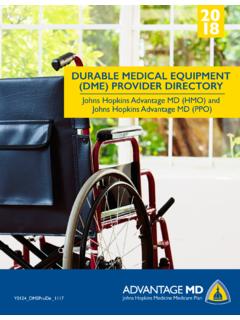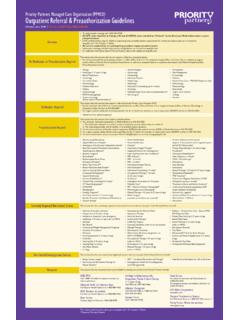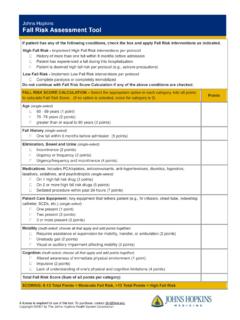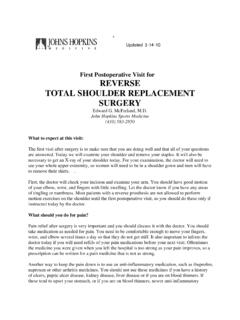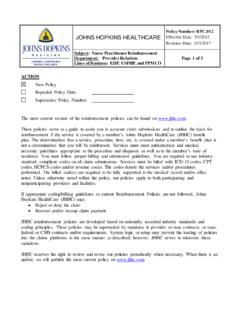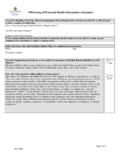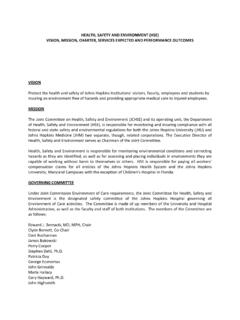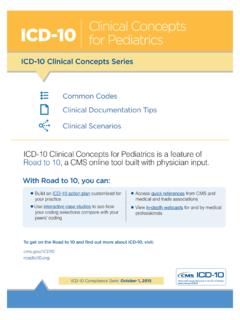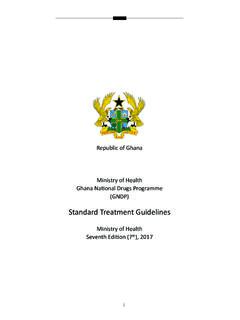Transcription of Bacterial Urinary Tract Infection (UTI)
1 4/4/2018 Bacterial Urinary Tract Infection (UTI) | Guidelines for Antibiotic NotesChange in mental status alone, without other signs and symptoms of UTI, is NOT sufficient to diagnose UTIC loudy or foul smelling urine does NOT mean UTI is presentPyuria either in the setting of negative urine cultures or in patients with asymptomatic bacteriuria usually requiresno treatment. If pyuria persists, consider other causes ( interstitial nephritis or cystitis , fastidious organsims)Follow-up urine cultures and/or urinalysis are only warranted for ongoing symptoms. They should NOT beacquired routinely to monitor for response to collectionThe urethral area should be cleaned with an antiseptic cloth and the urine sample should be collected midstreamor obtained by fresh catheterization.
2 Specimens collected using a drainage bag or taken from a collection hat arenot reliable and should not be of the urinalysis and urine culture Urinalysis and urine cultures must be interpreted together in the context of symptomsUrinalysis/microscopyDipstickNit rites indicate bacteria in the urineLeukocyte esterase indicates white blood cells in the urineBacteria: presence of bacteria on urinalysis should be interpreted with caution and is not generally usefulPyuria (more sensitive than leukocyte esterase): > 10 WBC/hpf or >27 WBC/microliterUrine culture If U/A is negative for pyuria, positive cultures are likely contaminationMost patients with UTI will have 100,000 colonies of a uropathogen.
3 Situations in which lower colony countsmay be significant include: patients who are already on antibiotics at the time of culture, symptomatic youngwomen, suprapubic aspiration and men with bacteriuriaPositive urine culture 100,000 CFU/mL with no signs or symptomsDo not obtain routine urine cultures in asymptomatic patients except in pregnant women during early pregnancyor in patients about to undergo urologic procedures in which mucosal bleeding is expected (NOT Urinary catheterplacement)Asymptomatic bacteriuria is common: 1 5% of premenopausal women, 3 9% of postmenopausal women, 40 50% of long-term care residents and 9 27% of women with cystitisDysuria, urgency frequency, suprapubic pain PLUS pyuria (>10 WBC/hpf ) PLUS positive urine culture 100,000 CFU/mLUncomplicated: female, no urologic abnormalities, no stones, no catheterComplicated: male gender, possible stones, urologic abnormalities, pregnancyAcute pyelonephritisFever, flank pain PLUS pyuria (>10 WBC/hpf ) PLUS positive urine culture 100,000 CFU/mLMany patients will have other evidence of upper Tract disease ( , leukocytosis, WBC casts, or abnormalitiesupon imaging) uncomplicated .
4 Female, no urologic abnormalities, no stones, no catheterComplicated: male gender, possible stones, urologic abnormalities, pregnancyBacterial Urinary Tract Infection (UTI)4/4/2018 Bacterial Urinary Tract Infection (UTI) | Guidelines for Antibiotic source of Infection with signs and symptoms of sepsisMicrobiologyE. coli (75-95%) is the most frequent organismStaphylococcus saprophyticus (5-15%) is seen in young females who are sexually activeOther Gram-negative organisms: Proteus mirabilis, Klebsiella pneumoniae, Enterobacter spp., of these organisms increases in patients with structural abnormalities in the Urinary Tract ,presence of nephrostomy tubes, hospital and long-term care facility patientsEnterococcus spp.
5 Can be a contaminant or colonizer, particularly in patients with Urinary catheters or multipleorganisms growing in urine aureus is rarely isolated from the Urinary Tract as uropathogen in patients without indwelling of S. aureus may indicate dissemination from the blood or other deep tissue; negative blood culturesshould be confirmed in patients without catheters or other Urinary Tract BacteriuriaNo treatment unless the patient is:PregnantAbout to undergo a urologic procedure in which mucosal bleeding on a case-by-case basis (NOT urinarycatheter placement)Consider treatment in renal transplant and neutropenic patientsTreatment NotesTreatment does not decrease asymptomatic bacteriuria or prevent subsequent development of UTIsTreatment is associated with increased risk of development of future UTIs that are antibiotic resistant andadverse events related to antibiotic useAcute CystitisUncomplicatedNitrofurantoin (Macrobid )
6 100 mg PO Q12H for 5 days ORCefadroxil* 1 g PO daily for 5 days ORCephalexin* 500 mg PO Q6H for 5 days ORCefuroxime* 250 mg PO Q12H for 5 days ORCefdinir* 300 mg PO Q12H for 5 days ORTMP/SMX 1 DS tab PO Q12H for 3 days ORIV option: Cefazolin 1 g IV Q8H for 3 days*Use Cefazolin susceptibility as a surrogate to predict susceptibilities for Cefadroxil, Cephalexin, Cefuroxime,Cefdinir for E. coli, K. pneumoniae, and P. mirabilis. For susceptibility interpretation for other organisms consult Urinary Tract Infection (UTI) | Guidelines for Antibiotic regimens as above except duration is 7 14 days based on clinical response and underlying risk factorsTreatment NotesUTIs in men are traditionally considered complicated.
7 UTIs in men in the absence of obstructive pathology( , BPH, stones, strictures) are uncommon. Please critically evaluate your diagnosis of UTI in male therapy is preferred and should be given unless patient is unable to tolerate oral therapyIf IV -lactams are used empirically for 3 days, no additional therapy is needed for uncomplicated cystitisIf IV -lactams are used empirically for < 3 days or treating complicated cystitis , the patient can be switched toan appropriate oral beta-lactam and duration of IV therapy should be counted towards total duration of therapyOral Fosfomycin can be used if susceptible for Gram-negative MDR organisms (susceptibilities must berequested) acute PyelonephritisCommunity-acquiredCeftriax one 1 g IV Q24H ORErtapenem 1 g IV Q24H (if history of ESBL)
8 ORSevere PCN allergy: Aztreonam 1 g IV Q8H OR GentamicinDuration: 7 14 daysHospitalized > 48 HCefepime 1 g IV Q8H ORSevere PCN allergy: Aztreonam 1 g IV Q8H OR GentamicinDuration: 7 14 daysStep-Down TherapyOral therapy should be used for pyelonephritis once susceptibilities are 500 mg PO Q12H for 7 daysTMP/SMX 1 DS PO Q12H for 7-10 daysCefadroxil* 1 g PO Q12H for 14 daysCefuroxime* 500 mg PO Q12H for 14 daysOral Fosfomycin can be considered if susceptible for Gram-negative MDR organisms (susceptibilities mustbe requested). Consult ID Pharmacist for dosing.*Use Cefazolin susceptibility as a surrogate to predict susceptibility for Cefadroxil, Cefuroxime and Cefdinir for , K. pneumoniae and P.
9 Mirabilis. For susceptibility interpretation for other organisms consult ID of empiric therapy should be counted towards total duration of therapyLonger durations may be required if associated with underlying Urinary Tract abnormalitiesUrosepsisCefepime 1 g IV Q8H ORPCN allergy: Aztreonam 1 g IV Q8H GentamicinDuration: 7 10 daysTreatment Notes4/4/2018 Bacterial Urinary Tract Infection (UTI) | Guidelines for Antibiotic Ciprofloxacin or TMP/SMX have excellent bioavailability and should be used as step-down therapy iforganism is susceptibleOral -lactams should not be used for bacteremia due to inadequate blood concentrationsDuration of empiric IV therapy should be counted towards total duration of therapyTreatment of EnterococcusEnterococcus spp.
10 Can be a contaminant or colonizer, particularly in patients with Urinary catheters or multipleorganisms growing in urine culture. Patients should be treated only if symptomatic unless they meet criteria fortreatment of asymptomatic bacteriuria. See asymptomatic bacteriuria section faecalisAlmost all isolates are susceptible to AmpicillinAmoxicillin 500 mg PO Q8H ORAmpicillin 1 g IV Q6H ORPCN allergy: Nitrofurantoin 100 mg PO Q12H OR Tetracycline 500 mg PO Q6H if susceptibleE. faecium (often Vancomycin-resistant) uncomplicated UTIsNitrofurantoin 100 mg PO Q12H if susceptible ORTetracycline 500 mg PO Q6H if susceptible ORFosfomycin 3 g PO once (susceptibility must be requested prior to its use)Complicated UTIsLinezolid 600 mg PO Q12H ORFosfomycin 3 g PO every 2 3 days (max 21 days)Treatment DurationTreatment duration is agent specific, see each treatment section above for durationManagementRenal Excretion/Concentration of Selected AntibioticsGood (> 60%).
